

 |
 |
 |
 |
 |
 |
 |
 |
 |
 |
 |
 |
This page is intended to be used by the collector of 16mm films to aid in the identification of the various kinds of film stock that one is likely to encounter. Please let me know if I have included any errors in this page. I am always trying to improve this page, and appreciate any suggestions. If you have comments please Contact Me.
Technicolor
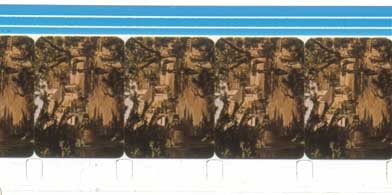
Blue Track Technicolor

Clear Edge (double rank) Technicolor

Black Edge (single rank) Technicolor
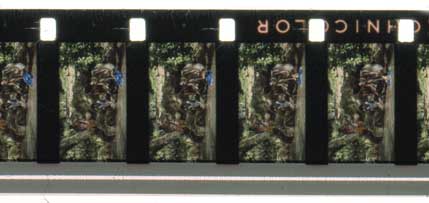
British Technicolor with black edge
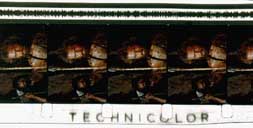
British Technicolor with clear edge (special thanks to John Schulien)
Technicolor: Called "IB Technicolor" for Imbibition. The most fade resistant color process. Found in 16mm from the mid 1940's to the early 1970's. A dye transfer process. The soundtrack is printed by itself onto black and white stock. The colors are mechanically printed from gelatin relief matrices onto this blank film. Three matrices are made from separation negatives for yellow, cyan and magenta. The film usually has no marking on the edges. The edges are usually clear. The soundtrack looks grey, and the film looks from the edge like black and white stock. Early Technicolor 16mm prints from the 1940's often had blue sound tracks instead of grey. Some prints have a grey stripe along the opposite edge from the sound track depending on its position in the printer. I have been told that the clear edge prints are double rank prints, made 2 at a time and then slit in 2, and the the black edge prints are single rank, but clear edge prints can be single rank also, in particular pre-1963 prints. Single rank prints supposedly have better color registration than the black edge single rank prints, but this is debatable. Technicolor prints made in the U.S. do not have any marking. British made Technicolor prints are usually black around the perforations like Kodachrome, and are marked "Technicolor Safety". Some of the British Technicolor prints have clear edges, with black lettering. British Technicolor also often has a lacquer coating to protect the emulsion.
Click Here for a history of 16mm Technicolor printing, courtesy of Eric Spilker
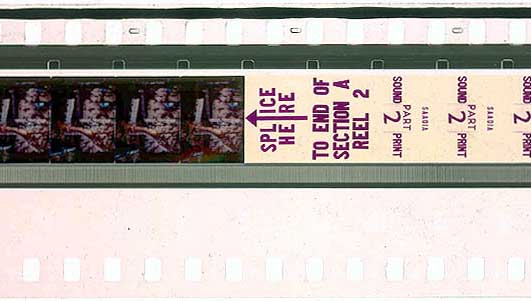
Scan of single rank 16mm Technicolor prior to slitting (special thanks to Brian Phillips)
Kodachrome and Eastman Reversal
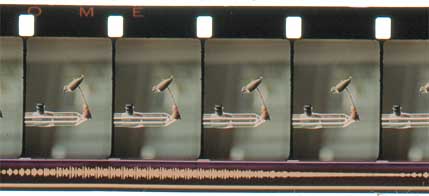
Kodachrome with "Yellow" (Sulphite) soundtrack

Eastman Reversal (Grey Track Kodachrome)
Kodachrome: A reversal (direct positive) process. 1936 to 2009. Never used for 35mm release prints, only 16mm and 8mm. (There was a special version known as Technicolor Monopack which was used for a few camera originals in the 1940s). Virtually fade proof. Most commonly used for amateur films for direct projection. I haven't seen any release prints made on Kodachrome since the 1970’s. Identified by being completely black around the perforations, with white (or similar light color) markings. Print stock comes in 2 types, ordinary Kodachrome, marked "Kodachrome Safety", which has a brownish (sulfite) soundtrack, and "Eastman Rev Color Safety Film", which has a grey silver soundtrack, similar to Technicolor. Kodachrome is high in contrast, and the contrast increases in printing, causing the shadows to be quite dark. For longevity of color, this is the next best thing to Technicolor. There are reports of the first production of Kodachrome having fading problems, but this was fixed around 1938.
Faded Kodachrome?
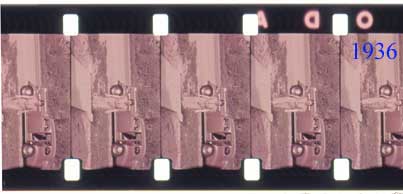
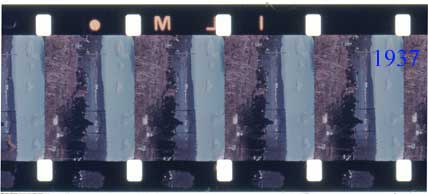
In the samples of silent film above, on was shot on Kodachrome with a date code of 1936 (shortly after introduction). The color has faded quite significantly. Another sample above shows Kodachrome with a date code of 1937. It shows no sign of fading. This indicates that the fading problem was fixed pretty early in the production of Kodachrome.
Anscochrome
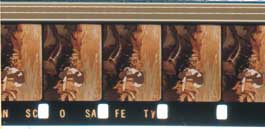
Anscochrome: A reversal process. Similar in appearance to
Kodachrome,
except for the markings. Not seen in a grey track version. Grainier
than
Kodachrome. Ansco from the 1950’s doesn't seem to fade, but some Ansco
from the 1940’s has a fading problem.
Cinecolor
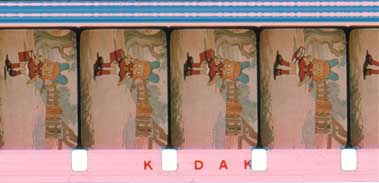
Cinecolor
Cinecolor: An early color process, used in the 1940's and
early
1950's. Cinecolor is a 2 color process. The blue emulsion is on one
side
of the film, and the red emulsion is on the other side. The sound track
is usually blue, and the film is marked "Kodak Safety". Cinecolor is
fade
resistant, but the colors are not very accurate. Most commonly seen
used
for cartoons. There is also a 3 color process called Super
Cinecolor,
but it is relatively rare. I don't know if any 16mm prints were
ever made in Super Cinecolor.
More about Cinecolor:
There was probably never Super Cinecolor in 16mm, only
35mm. Cinecolor is notorious for "yellow laddering," a
deterioration that
happens given the fact that many Cinecolor prints had a yellow layer
added to them to give better color rendition that seeps on frames that
were wound next to them. As these frames are not exactly lined up, it
gives a weird yellow image that ghosts its way up and down the film.
Not fixable. Not all Cinecolor prints do this, but many do. Cinecolor
is also notable for having Eastman edge codes that are usually bright
red or blue. There was, however, 16mm Trucolor. Trucolor was a
Dupont process
with a blue track and it does fade. You'll find Republic releases on
Trucolor. There was also
a Super Trucolor in 1953-4, which also fades a hair, and it used
Dupont's two-color stock with a DYE TRANSFER (!) yellow layer. I
have not seen this on 16mm, but have on 35mm.
(Thanks to Eric Grayson).
Ektachrome

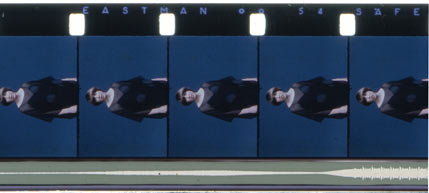
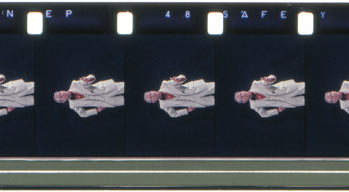
Ektachrome: A reversal process. Similar in appearance to Kodachrome, except for the markings. Occasionally seen in a grey (silver) sound track version. The scan above has a silver sulfite track 1950’s to present. The lower scan has a silver track, and is marked "Eastman Safety" It does not say Ektachrome anywhere. This sample dates from 1979 Another sample from the same time is marked EP. Most commonly used for camera originals for duplication or direct projection. Favorite of TV news crews in the magnetic sound version. Unusual on release prints. Ektachrome from the 1960’s and newer seems to hold up OK, but Ektachrome from the 1950’s is fading badly.
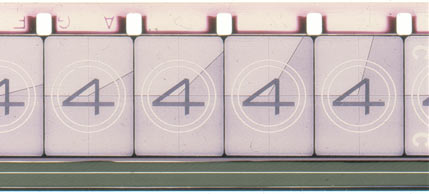
A Red Herring: What is this? It looks like Agfa-Gevaert with at grey track! Is it possible? Nope, it's a trap for the unwary film identifier. A leader printed on A-G is attached to a camera original on Ektachrome. A release print is made on Ektachrome print stock with the light extending to the sprocket edges, which copies the edge codes from the original.
Eastmancolor
Eastmancolor: What is usually called Eastman color is the
print
stock made from the mid 1950’s to the early 1980’s. This is a
positive-negative
process. Clear around the perforations with a very light pink or orange
cast. Markings along the edge in red, sometimes very small.
Eastmancolor is the stock
most
prone to fading. Some later versions (sometimes erroneously called
"4b")
seem to hold up better, similar to SP. Many films have turned so that
nothing
but red is left. Rate of fading depends on the quality of
processing
as well as storage conditions. Color film emulsions are
made up of cyan, yellow and magenta layers. The cyan layer
will fade first. This initially causes the shadows to go maroon,
then blue skies turn white, and eventually all you have left is
red.
 Some prints are reported to be on Eastman "4b" stock, which is claimed by some to be a relatively low fade stock. What people call "4b" is a code on the edge of Eastmancolor stock that consists of various lines and/or dots. Sometimes these look vaguely like the characters "4b". It is believed that these codes indicate the slitter machine when the film stock is cut down from a wide roll to 16mm width. There are several different codes that appear on various Eastman stocks over many years. Tom Robinson at the Oregon Historic Photo Archive has put together a chart of the various slit codes he has seen. "4b" is not on his chart, but by extrapolating his chart, it would mean slitter 46. Here is the link to his chart, which also includes Eastman date codes: http://www.historicphotoarchive.com/f1/16ekcode.html Thank you Tom! Around the time that this code was appearing on the film, Eastman was making small quantities of a stock with improvements to the cyan stability, but these were not specially marked. I have seen some badly faded prints marked with the code identified as "4b", so this is not really a sign of a low fade print. Most of these are also only a little more than 20 years old, so if they were stored properly, fading should be just starting. One thing that I have noticed is that for stock made in the late 1970's, the "4b" (46) marking appears more frequently than other codes. |
More about Eastmancolor
Eastman Kodak introduced two low fade 16MM stocks in 1979, Eastman
Color LF Print film 7378 and Eastman Color LFSP film 7379. The latter
film
used the higher temperature ECP-2 process whereas the 7378 used the
standard
ECP Process. These films had much improved cyan-layer fading
characteristics
than the 7381/7383 stocks. As far as I know, these were not
marked
in any special way, and were available in parallel with the standard
Eastmancolor,
possibly at a higher price. These films were discontinued about
1982/83
when KODAK introduced their 5384/7384 Eastman Color Print film with
excellent
low fade properties (LPP) and this film was used for making practically
all prints from 16mm and 35mm color negatives. (Thanks, Peter,
for
the information on these).
Kodak SP


Kodak SP: Stands for "Special Process". I thought it was "Slow Phade". Marked "Safety Film Kodak SP". Mostly used in the 1970’s. Holds up better than standard Eastmancolor. Tends to turn brownish in the shadows. Some of it has held up quite well, others are noticeably brown. In the particular sample in the scan, the greenish-gray background around the perforations indicates that it was printed to show edge numbering from the negative. This type of printing is found on many types of neg/pos stock, not just SP, and not all SP is printed like this. In the lower picture there is marking in white. This is from the negative, not the positive print. This can be confusing. The soundtrack is a dual bilateral variable area. It is not stereo, both tracks are identical.
More about SP:
SP was introduced about 1974, at about the time
that KODAK introduced their then new Eastman Color Negative II
5247/7247
films. According to KODAK the only difference between SP (7383)
and
their standard Eastman Color print film (7381) is that it used a higher
temperature processing bath and a shorter processing time. Kodak
probably did not make any claims that this film had better fading
characteristics
compared to their standard Eastman Color print film (7381).
(Thanks
Peter).
Eastman LPP

Eastman LPP: Stands for "Lowfade Positive Print".
Marked
"Eastman LPP Safety". Used since the early 1980’s. Possibly the best
dye
permanence of the negative/positive processes. Nice, rich colors
without
excessive contrast. In the early 1990s Kodak changed their edge
marking
system, and newer prints aren't marked LPP, even though they are, and
some
use the new stock code system. See Kodak's web site for details.
http://www.kodak.com/US/en/motion
LPP is type 5384/7384 and was replaced around 1998 with the Kodak
Vision
series.
Eastman Post-Lpp

Recent Eastman film is no longer marked LPP, though it is
considered a low fade stock. Note that the year of manufacture is
no longer a code.
Kodacolor
Kodacolor movie film is really strange stuff. It was made from about 1928 to the early 1930s. It is an additive process where the film has a black and white emulsion. The film has lenticular ridges on the base side. It is exposed through the base with a special filter on the lens having red green and blue stripes. The ridges on the base cause the red, green and blue content of the image to be exposed in vertical stripes under the filters. A matching filter is on the projection lens.
Fuji
Fuji: Generally good fading characteristics, but some of the
older stuff can fade slowly, tending toward the Purple. Marked "Fuji
Safety"
or "Fuji Film Safety". There is a date code with the 2 digits
representing
the year of manufacture.
More about Fuji: Fuji had a competitive process with SP that was marked HP, approximately the same years. It, too, fares a bit better than regular Fuji. Fuji changed chemistry in 1982 or 1984 along with Eastman and has since gotten the same excellent low-fade characteristics. Beware 1978-79 Fuji. There is some weird chemical that causes it to grow mold and deteriorate wildly. Can be nasty. (Thanks to Eric Grayson).
Agfa-Gevaert
Agfa-Gevaert: Usually as fade resistant as LPP. Marked "AG
1S",
"AG 2S", Earlier films are sometimes spelled out "Agfa –
Gevaert". If it is marked just "Agfa" or just "Gevaert", it was
likely produced prior to the merger of Agfa and Gevaert in 1964.
Sometimes it's just marked "1S" or "2S" without the "AG". I
think it holds up better than Fuji. When it fades, it tends to lose
some color saturation, but does not turn red. I have no idea what
the 1S and 2S
mean.
It is reported that some of the earlier stuff fades a bit, but not very
much, and the newer stuff is very good. I have been told that the
1S and 2S designation indicates single or double rank printing stock,
can anyone confirm or deny this?
3-M (Ferrania)

3-M: Colors sometimes hold up OK, sometimes turn red as a beet.
Usually turn brownish. Sometimes marked "3M", sometimes not marked at
all.
Earlier (and current, if they are making any movie stock) stock was
marked Ferrania. 3-M bought Ferrania around 1960, and spun it off
again recently.
CRI
CRI: This is not a print stock, but is used in an intermediate process. It stands for Color Reversal Intermediate. It was a special film stock used for making internegatives. The purpose of this was to avoid the extra step of making an interpositive, so that an internegative could be made directly from the camera negative. Most CRI prints are on Eastmancolor, Sometimes a later process such as SP or LPP, but often on plain old Eastman, though it can also be Agfa-Gevaert or Fuji. This process was used mostly between 1968 and 1987, so later prints made from a CRI haven't faded much yet. It still has no bearing on fade resistance, and is often confusing. Sometimes prints made from a CRI are grainier than those using other intermediates. The internegatives on CRI were reputed to fade quite badly.
Sound Tracks
Despite differing appearances, all 16mm optical sound tracks are
compatible with standard sound projectors. Projectors with the
ability to play magnetic sound tracks are less common.
Variable Density Soundtrack

Variable Density track is an older type, originally the "Western
Electric"
track. It is found mostly on B&W films, though it is
sometimes
seen on Kodachrome films, or on later reprints from older negatives.
Single Variable Area Soundtrack

Enlargement of a single variable area sound track. This was
originally
the RCA type of track, though it could also be made with Maurer and
later
Western Electric sound recorders. This example is on A-G stock,
but
could be on any stock. The dual variable area track is more common.
Dual Variable Area Soundtrack
![]()
Dual Variable Area is the most common type of soundtrack. Both
tracks are identical. It is not stereo. There are rumors
that
there was a brief experiment with Dolby stereo soundtracks in 16mm, and
some prints were made for the U.S. military, but none of these have
been
seen by collectors. Stereo tracks in 35mm look similar to this,
but the modulations will be different on each track.
Multiple Variable Area (Maurer) Soundtrack

The above picture shows a Maurer multiple VA track. There are
6 identical tracks. This just happens to be on a piece of LPP
stock,
which is actually unusual, since this type of track was most popular
long
before LPP was available.
More about the Maurer Soundtrack:
From “Audio Cyclopedia”, by Howard M Tremaine (1969 Howard M.
Sams)
Page 915.
“In Multiple Variable-area sound-track recording, six or more identical
bilateral sound tracks are recorded side by side. Such sound
tracks
are generally used with 16-mm photographic sound recording. The
advantages
claimed for this method of recording are that because the tracks are
quite
narrow, distortion caused by azimuth deviation and uneven slit
illumination
is considerably reduced, and the signal-to-noise ratio is
increased.
This type sound track is used by Maurer, and the German
Tobias-Klang-film
Co. A method of recording 13 sound tracks, developed by
Siemens-Halske,
also of Germany, has been described in the literature.”
Unilateral Sound Track

The unilateral sound track is less common than other types of
optical tracks. It had pretty much fallen out of use by the
1950s. It was also used in the Auricon direct sound-on-film
camera which was produced mainly in the 1950s. Many of these were
converted to use in kinescope recording (filming of television picture
and sound), so some kinescope recordings are found with unilateral
tracks.
Dual Unilateral Sound Track

This looks like a negative of a single variable area track, but
notice how the white portion gets narrower in quiet passage as noise
reduction. Not a very common track type, but more common than
single unilateral.
Magnetic Sound Track

Magnetic track is brown, usually a balance stripe is on the other edge
for even winding. Sometimes it is half width to add a second
language
and still have an optical track. Requires a projector with
magnetic
playback capability. The picture above is on Ektachrome.
This was commonly used for TV news gathering with "single system"
cameras that recorded sound in the camera.
Silent Film Stock
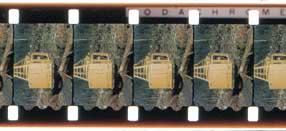
Silent film differs from sound film in that it has perforations on
both edges. The scan above is on Kodachrome.
Film Base
The plastic film base for 16mm is either Acetate or Polyester.
No 16mm stock was manufactured on Nitrate base, though it was used for
35mm films until 1950. Acetate is the
earlier
material, and is susceptible to "Vinegar Syndrome", a deterioration of
the base, emitting a vinegar odor and causing warping and
shrinking.
Polyester was introduced in the 1970s and is much more stable.
Polyester
is frequently referred to by Kodak's trade name of "Estar".
| A
non-destructive method to tell Polyester
(Estar,
etc.) from Acetate One technique is to use crossed polarizers, such as camera filters or 3-D glasses. Overlap the polarizers, and orient them so that they are opaque. Place the film between them. If it is acetate, it will appear opaque. If it is polyester (Estar, etc.) it will depolarize the light, and the area of the film will appear less opaque. |
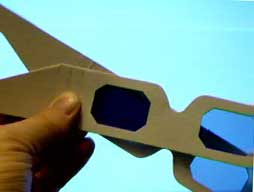 |
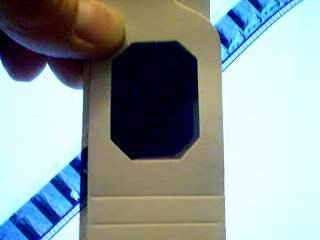 |
 |
|
|
|
Date Codes:
Sabucat has has moved their very handy chart of Eastman Kodak date codes to:
http://www.amianet.org/sites/all/files/date_code.pdf
Thank you, Jeff!
Some newer Kodak stocks use the key code system:
http://motion.kodak.com/KodakGCG/uploadedfiles/motion/Guide_to_Identifying_Year_of_Manufacture.pdf
Kodak's web site has much more useful information, for example the
Chronology
of MP Films:
http://motion.kodak.com/motion/About/Chronology_Of_Film/index.htm
Kodak has a variety of useful documents at:
http://motion.kodak.com/motion/Education/Publications/index.htm
Edge markings and date codes too small to read? Pull the lens out of your projector, it makes an excellent loupe for reading film markings!
Copyright 2001-2011, Paul Ivester. All
rights
reserved.
Please don't copy text or images from these pages without
permission. This means you, Bob!
Last revised Mar 14, 2016